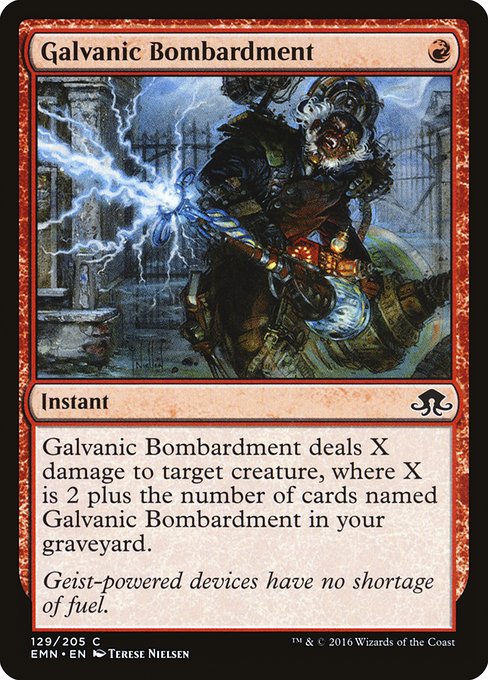
Image courtesy of Scryfall.com
Templating Matters: Reading Galvanic Bombardment for Clarity
In the realm of MTG, the quiet engine that powers clever plays is templating—the way a card’s rules text is worded to produce a precise outcome. A single red instant from Eldritch Moon offers a textbook case: Galvanic Bombardment. Its text reads, quite literally, “Galvanic Bombardment deals X damage to target creature, where X is 2 plus the number of cards named Galvanic Bombardment in your graveyard.” The formula is elegant, but the way it’s phrased can trip up new players and seasoned veterans alike. 🧙♂️🔥 The challenge isn’t what the effect does; it’s how the words tell you how big the blast will be—before you sling it across the battlefield.
“Geist-powered devices have no shortage of fuel.”
Reading the X: A template you can trust
The heart of the card is a simple mathematical template: start with a base of 2 damage, then add one for every copy of Galvanic Bombardment that’s in your graveyard. The phrasing makes the mechanic crystal-clear once you train your eye to parse it at the moment of resolution. If you have zero copies in the graveyard, you’re dealing 2 damage. If you’ve managed to mill, copy, or otherwise move a single Galvanic Bombardment into your graveyard, the next bolt becomes 3. Two copies in the graveyard bumps it to 4, and so on. This is where templating shines—and where it can mislead if the moment-to-moment state of the graveyard isn’t tracked. A quick mental tally, or a compact tracker on the table, helps keep everyone aligned. 🧭
Because the text specifies “the number of cards named Galvanic Bombardment in your graveyard,” the trigger isn’t about how many copies you own in your deck or hand. It’s about the actual stack of remembered spells in the graveyard at the time the spell resolves. That nuance matters for players who run graveyard strategies, or those who lean on effects that copy, reanimate, or otherwise redeploy nametags of themselves. The result is a clean, scalable plan: the more named copies in the graveyard, the bigger your finisher can be. It’s a small templating choice, but it reshapes how you sequence draws, dumps, and recurs in the game. 🧩
Strategic applications: where templating shines
Galvanic Bombardment fits nicely into red shells that like to tempo and menace, then finish with a controlled blast. In early turns, you can cast it as a compact removal option—two damage can still pick off a 2/1 or whittle down a stubborn blocker. As your graveyard fills with copies, the spell grows more ambitious. A couple of well-timed copies in the graveyard can turn a 2-damage ping into a decisive swing, especially when you’ve already chipped away at your opponent’s board with habitual removal and efficient plays. The template rewards thoughtful build-around ideas: ways to add copies into the graveyard, ways to copy or recast the spell, and ways to pressure the opponent so they can’t safely ignore the looming X-damage threat. This is the magic of templating in motion: a single line of rules text unlocks a spectrum of tempo, reach, and inevitability. 💥⚡
From a design perspective, the card’s economy is tight and approachable. It’s common and affordable, a welcome entry point for players exploring graveyard interaction without sinking a lot of mana into a single trick. It also teaches valuable lessons about how much arithmetic is acceptable to expect players to do on the fly. Wizards of the Coast consistently threads readability into the fabric of templating, and this card is a compact tutor on that craft. For fans of flavor and function, the line “Geist-powered devices have no shortage of fuel” plays beautifully with the artwork: gears, glow, and the ghostly technicians behind the magic. The result is a card that isn’t just a tool but a conversation piece at the table. 🎨
Flavor, art, and collector context
Terese Nielsen’s art pairs with Eldritch Moon’s gothic-industrial mood, turning a tiny red spark into a furnace of calculation. The circular logic of the spell’s X-damage feels like a miniature engine: a base burn that purrs up as you fill the graveyard with the namesake card. The flavor text underscores the archetype’s theme—magic powered by restless spirits and the odd, gleaming gadget. In the collector ecosystem, Galvanic Bombardment sits among common prints, with a price tag that mirrors its relative ubiquity (roughly a fraction of a dollar for nonfoil and a touch more for foil). Its EDH/Commander footprint may be modest, but it still finds friendly homes in casual red decks that enjoy scaling finishers. It’s not a flashy centerpiece, yet it embodies a core MTG truth: clarity in templating empowers players to craft smarter, more dynamic spells. 💎⚔️
As you plan your next red burn or graveyard-laced assault, consider how your reading of the card’s template shapes your choices. Do you race out, hoping to press the edge with a couple of early swings? Or do you lean into the strategy, setting up a furnace of hits that only grows hotter as the game unfolds? Either way, the clarity of the text keeps the play honest and the drama high, which is exactly the kind of tension MTG fans crave. 🧙♂️🎲
And while you’re absorbing the joy of templating mastery, a small reminder from the real world: even a sleek, minimalist accessory can make a difference in daily life. If you’re juggling travel decks, sleeves, and notes on game nights, a slim, reliable phone case can keep your gear safe as you shuffle into the next match. To that end, consider a practical companion for your collection: a Slim Phone Case Glossy Lexan PC Ultra-Thin Wireless Charging device—crafted to protect and travel as smoothly as your game plan.
Slim Phone Case Glossy Lexan PC Ultra-Thin Wireless Charging
More from our network
- https://blog.digital-vault.xyz/blog/post/luminous-blue-giant-reveals-binary-motion-signatures/
- https://transparent-paper.shop/blog/post/streamlining-feature-updates-clear-confusion-free-rollouts/
- https://blog.digital-vault.xyz/blog/post/the-art-of-frankie-peanuts-elevates-mtg-flavor/
- https://blog.digital-vault.xyz/blog/post/refined-stellar-parameters-reveal-a-reddened-hot-giant-at-19-kpc/
- https://crypto-acolytes.xyz/blog/post/slay-the-spire-vs-monster-train-deckbuilding-showdown/